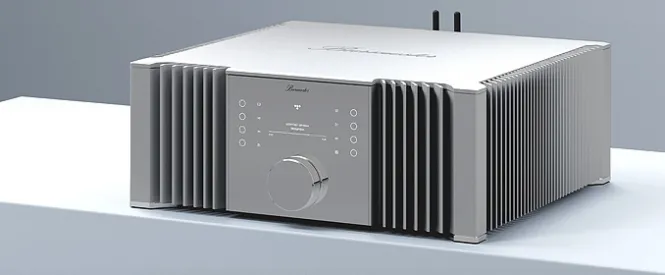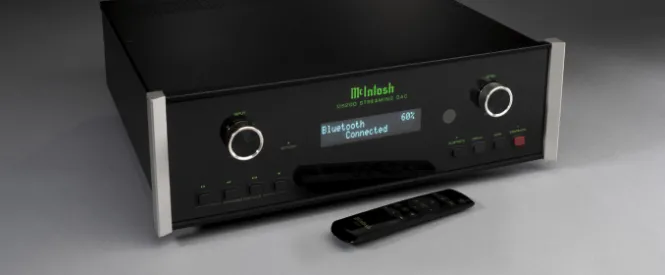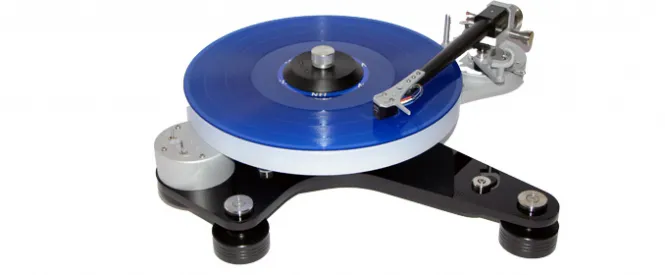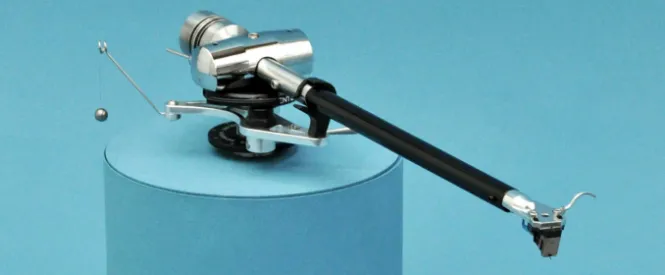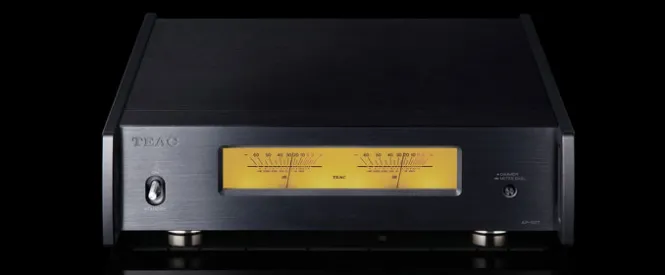Cyrus Classic AMP & PSX-R2 Power Supply Review
Michael Evans discovers that less is more with this attractive and diminutive integrated amplifier and power supply combination…
Cyrus Audio
Classic AMP Integrated Amplifier + PSX-R2 PSU
£1,995 + £995 RRP
Originally under the aegis of Mission, Cyrus has been making high-quality 'affordable audiophile' hi-fi since the mid-nineteen eighties. For many of us who have followed the brand's progress over the years, its most praised product was a dinky little integrated amplifier introduced in 1984 called the Cyrus 1. Being a striking-looking, half-sized minimalist design, it perfectly caught the eighties hi-fi zeitgeist. It dared to be different in a very crowded market and succeeded thanks to class-leading sound – with its more expensive Cyrus 2 sibling soon proving just as popular in one market segment further up.
Since then, there has been a steady stream of Cyrus products emanating from the Huntingdon, Cambridgeshire headquarters – amplifiers of the integrated, pre and power variety, plus power supplies, CD players, tuners and streamers. The latest Classic AMP you see here reflects this provenance – it's a well-thought-out integrated housed in the company's classic, beautifully finished diecast casing and measures 215x75x365mm (6.7kg).
It features several analogue line-level inputs with a very decent moving magnet phono stage. If this was not enough, it sports a built-in DAC with two coaxial and two optical digital inputs.
UP CLOSE
Said to provide "a significant step up in performance from previous versions", thanks to knowledge amassed from developing the high-end XR Series, it's a classic Class AB design with a claimed 70W RMS per channel into 8 ohms and 112W per side into 4 ohms. Cyrus says that the majority of the internal components have been upgraded by its design team for this new amp. The preamp section features a relay selection for the analogue ins and is electrically separate from the power amp section, being driven by its own transformer winding. Digital control circuits are assigned a separate mains power supply, completely isolated from the signal circuitry, the company says.
The Classic AMP has a 340VA toroidal power transformer, which feeds a high-capacity power supply reserve. As with all higher-end Cyrus products, it has a port for use with the optional, matching PSX-R power supply. Power from this is routed internally to the analogue stages of the preamplifier to provide a more stable, low-noise power supply for the analogue preamp and post-DAC stages of the digital converter, says Cyrus. The built-in moving magnet phono input features dual active gain stages and passive RIAA equalisation; an input sensitivity of 2.3mV is quoted, which is just about ideal for modern MMs.
This little integrated amplifier comes with an internal 24-bit, 192kHz-capable DAC, but is arguably the weakest link in the package as it cannot do DSD. Still, if that doesn't bother you – and DSD is not exactly mainstream, lest we forget – then don't be put off the rest of the package. A good standalone DAC is an obvious upgrade path at a later date, and there are a plethora of them on sale to choose from when the time is right. Meanwhile, this is good enough to be getting on with.
Other niceties include unbalanced preamplifier outputs, a fixed-level record output, a 3.5mm headphone jack (admittedly a bit fiddly to reach) and a firmware upgrade port. The cramped back panel is a model of modern design, with vast amounts of connectivity sandwiched together neatly and logically. I also particularly like the remote control, which is weighty, backlit, motion-sensitive and can learn commands. It's a refreshing change to the bundled generic ones we see too many of elsewhere.
Switching the Classic AMP on proudly shows "made in Britain" on the central display, and with a couple of reassuring relay clicks, the amp springs into life…
THE LISTENING
The Classic AMP is, just as its name suggests, classic Cyrus! That means you get a fast, detailed and engaging-sounding amplifier that's capable of producing an excellent soundstage. But this doesn't mean that it's hard, forward or in your face, because it isn't. Rather, it treads a careful line that attempts to give the best of both worlds. Many audiophiles outside the UK tend to characterise it as "the British sound"; it's not fat and soft, but neither is it hard and tinselly; instead, this amplifier gets the sonic balance just right.
Proof of this comes from the Classic AMP being relatively agnostic about partnering sources and loudspeakers. In my case, I tried it with multiple front ends – from the latest streamer from Cambridge Audio, the MXN 10, via a Chord Qutest DAC to a Rega Planar 3 turntable. I also used a new Sony Blu-ray player to feed the Cyrus's internal DAC. Everything sounded very good through these sources, with the built-in phono stage being a particularly nice surprise. This amp also drove a wide variety of loudspeakers. Indeed, surprisingly, it worked great with a new pair of Falcon Acoustics LS3/5as, a classic mini monitor that is notoriously hard to drive.
Tonally, the Classic AMP is very neutral, although when playing Rush's The Camera Eye, I did hear just a slight opacity to the midband. This wasn't a big deal, though, as you have to pay a good deal more on the integrated amp market to do any better in this respect. Bass is taut and tuneful, albeit again, compared to bigger, more expensive integrateds like Exposure's 3510, not the gutsiest. Adding a PSX-R2 power supply helped a lot here by the way, more of which later. Treble is smooth and sophisticated, with good insight into the sound of, for example, Neil Peart's heavily struck hi-hat cymbals. A little sweet but not syrupy, the top end ultimately lacks atmosphere and sparkle, but then so do all its price rivals.
Connecting up the PSX-R2 power supply was a real ear-opener. Recordings with strong rhythm sections such as Love Is The Drug by Roxy Music, or Pull Up To The Bumper by Grace Jones, left me feeling that this external box brings a lot to the party. Bass was tangibly deeper, drums faster and more dynamic, and some of the subtleties within the playing of the cymbals and hi-hats became better defined. The Classic AMP began to sound like a really talented performer – the sort of amplifier for which no excuses need to be made.
It seemed to unlock the amp's naturally fluid and expressive bass, giving it extra get up and go. The more thumping the song's bassline, the more this was evident – Thomas Dolby's Pulp Culture being a case in point, where the bottom end tightened up and got more defined. Charlotte Martin's cover of Kate Bush's Cloudbusting features beautifully recorded piano and vocal work, and the Classic AMP/PSX-R2 did great justice to it. The recorded acoustic was superbly reproduced, with vibrant texture and impressive air and space – the extra power supply making the song sound more expansive, expressive and natural; less processed, in other words…
Frustratingly, however, switching off the PSX-R2 power supply and running the Classic AMP on its own again feels like a downgrade. So much so that if you do audition the PSX-R2, you will inevitably end up wanting one and probably also buying one. It really does make a noticeable difference. It's not that it fundamentally changes the character of the amplifier, but it just exposes more of the good bits. I found myself more immersed in the music, as somehow it became easier and more enjoyable to listen to.
In truth, this is the case with many hi-fi products with optional power supplies – as Naim owners will attest – so what's the problem? Well, if you can afford the Classic AMP and PSX-R2, then you should be buying the i9 XR amplifier instead! The latter isn't far off the price of the aforementioned combination, yet sounds even better to my ears. The latter is a seriously impressive product that outperforms the Classic in every department, and as a flagship product, so it should. And guess what? It's also upgradable with the addition of a PSU-XR power supply.
THE VERDICT
 The Cyrus Classic AMP is an excellent amplifier at its price; it sounds just about as good as anything else you can buy for this money – and has the benefit of lovely build quality, slick and compact packaging, a great MM phono stage and a decent remote control.
The Cyrus Classic AMP is an excellent amplifier at its price; it sounds just about as good as anything else you can buy for this money – and has the benefit of lovely build quality, slick and compact packaging, a great MM phono stage and a decent remote control.
Also, it's easily upgradable by the plug-in power supply at a later date; none of its rivals, like the Rega Elicit Mk5, Naim Nait XS3 and Exposure 3510, offer this upgrade path. As I found out, though, the only downside to the addition of the PSX-R2 is that it takes it up to the price of its closest rival – Cyrus's very own i9 XR! To make sense of the upgrading decisions, I strongly recommend that you head down to your friendly local Cyrus dealer and let your ears decide. Meanwhile, this company's success goes from strength to strength, and justifiably so.
Visit Cyrus Audio for more information
Michael Evans
A music junkie who served his apprenticeship in UK hi-fi retail in the 1990s, Mike loves the simplicity of analogue and the complexity of digital. With an encyclopaedic knowledge of the subject, he’s been on a life-long quest for great sound at a sensible price – and is still loving the journey…
Posted in: Accessories | Power Supply / Conditioning | Amplifiers | Applause Awards | 2023 | Hi-Fi
JOIN IN THE DISCUSSION
Want to share your opinion or get advice from other enthusiasts? Then head into the Message
Forums where thousands of other enthusiasts are communicating on a daily basis.
CLICK HERE FOR FREE MEMBERSHIP
Trending
applause awards
Each time StereoNET reviews a product, it is considered for an Applause Award. Winning one marks it out as a design of great quality and distinction – a special product in its class, on the grounds of either performance, value for money, or usually both.
Applause Awards are personally issued by StereoNET’s global Editor-in-Chief, David Price – who has over three decades of experience reviewing hi-fi products at the highest level – after consulting with our senior editorial team. They are not automatically given with all reviews, nor can manufacturers purchase them.
The StereoNET editorial team includes some of the world’s most experienced and respected hi-fi journalists with a vast wealth of knowledge. Some have edited popular English language hi-fi magazines, and others have been senior contributors to famous audio journals stretching back to the late 1970s. And we also employ professional IT and home theatre specialists who work at the cutting edge of today’s technology.
We believe that no other online hi-fi and home cinema resource offers such expert knowledge, so when StereoNET gives an Applause Award, it is a trustworthy hallmark of quality. Receiving such an award is the prerequisite to becoming eligible for our annual Product of the Year awards, awarded only to the finest designs in their respective categories. Buyers of hi-fi, home cinema, and headphones can be sure that a StereoNET Applause Award winner is worthy of your most serious attention.

